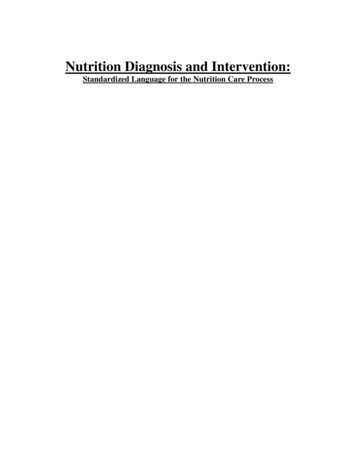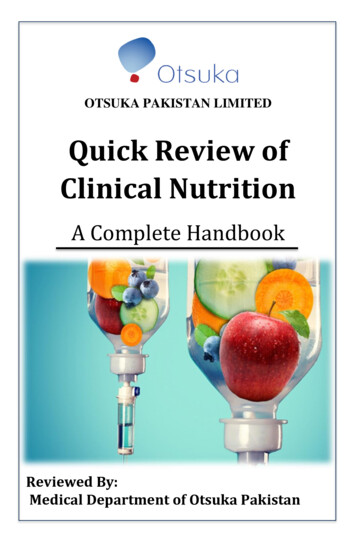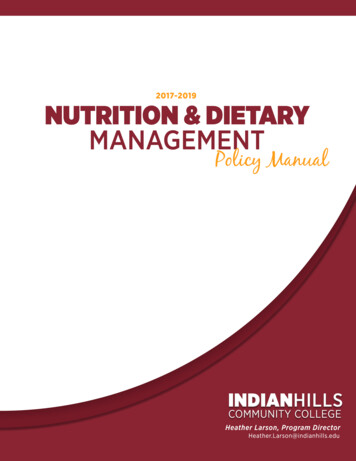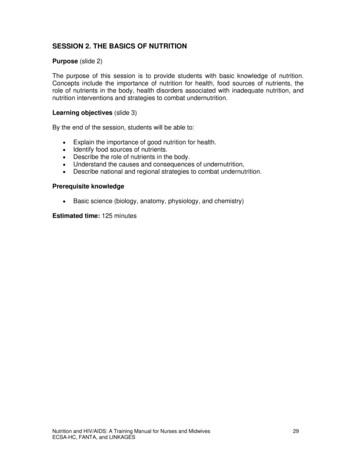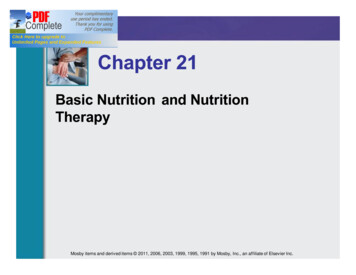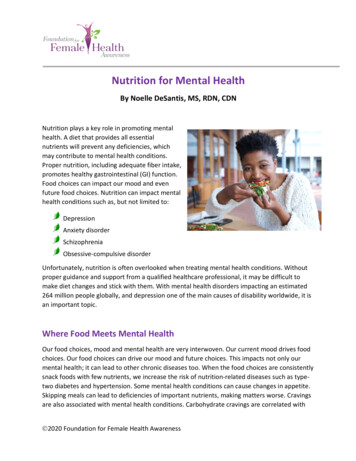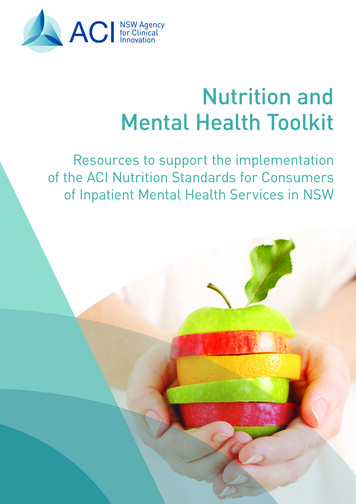
Transcription
Nutrition and Health:Issues and InsightsJamie Pope, MS, RDN, LDN, FANDAssistant Professor, Nutritional SciencesVanderbilt University School of NursingDATES: Tuesdays and Thursdays, June 18, 20, 25, 27; July 9, 11TIME: 10:00 a.m.–11:30 a.m.LOCATION: Scarritt Bennett Center, Laskey Hall, 1008 19th Ave S
Food and Health SurveyIFIC – International Food and Information CouncilSource: www.foodinsight.org
rallBest Diets Overall#1 Mediterranean Diet#2 DASH Diet#3 Flexitarian Diet#4 MIND Diet#4 Weight Watchers Diet#6 Mayo Clinic Diet#6 Volumetrics Diet#8 TLC Diet
How Eating Plans rticles/how-us-newsranks-best-diets A panel of nationally recognized experts in diet,nutrition, obesity, food psychology, diabetes and heartdisease rated each diet considering: how easy to follow hat-makes-adiet-easy-to-follow ability to produce short-term and long-term weight loss nutritional completeness conformance with 2015 Dietary Guidelines for Americans safety and potential for preventing and managing diabetesand heart disease
Jamie PopeSteven NizielskiVanderbilt UniversityGrand Valley State UniversityNutrition: FOR A CHANGING WORLDSECOND EDITIONChapter 2Healthy DietsCopyright 2019 W. H. Freeman and Company
What is a Healthy Diet? A healthy diet should: Meet nutrient and calorie needs at different life stagesHelp maintain a healthy body weightHelp prevent chronic diseasesFoster an enjoyment of eating and appreciation of food
Adequacy, balance, variety and moderationare the core characteristics of healthy diets Characteristics . Adequate amounts ofessential nutrients Balanced across foodgroups andmacronutrients Variety of foods Moderation and notoverindulging
Healthy diets include foods that are good sources of anumber of nutrients relative to the amount of calories. Nutrient-dense foods Provide healthy nutrients in appreciable amounts relative tocalories Energy-dense (or empty calorie) foods Provide calories and low amounts of nutrients It is easier to build an adequate and healthy diet aroundnutrient-dense foods than around empty calorie foods.
The typical American diet does not align withrecommended limits or goals Excessive amounts of energy-dense foods Insufficient amounts of nutrient-dense foods
Healthy diets include foods that are good sources of anumber of nutrients relative to the amount of calories Nutrient-dense foods provide healthy nutrients in appreciable amounts relative tocalories Energy dense (or empty calorie) foods provide calories and low amounts of nutrients It is easier to build an adequate and healthy diet aroundnutrient-dense foods than around empty calorie foods
Nutrient Dense and Non-Nutrient DenseForms of Sample Foods
Energy density is the number of calories in agiven volume of food Energy density (calorie-density) Number of calories in a portion of food divided by thefood’s weight in grams Example: 107 calories in 20 grams of potato chips Energy density: 107/20 5.4 Fat, sugar and alcohol tend to increase energy density Fluid (water) and fiber tend to decrease energydensity
The water, fiber, and fat content of foods is theprimary factor that determines energy density
For an equal number of calories, portion size decreases asenergy-density increases
Eating a low energy-densediet allows you to eat a larger volume of food,all while maintaining energy balance
Energy Density of Common f/r2p energy density.pdfComparison of three methods to reduce energy density: effects on daily energy intake(Appetite) 87/
Processed foods exist along a continuum
Dietary Guidelines for Americans areupdated every five years Issued by the US Department of Agriculture (USDA) andUS Department of Health and Human Services (HHS) s/ Evidence-based guidelines to promote health and reducerisk for major chronic disease Intended for health professionals to help people age 2 and overconsume a healthy diet and prevent chronic disease basis for Federal food andnutrition policies, programs,and education
Dietary Guidelines for Americans over the years .200020101980198519952005
2015 Dietary Guidelines for AmericansOverview Five overarching guidelines to steer population towards a healthyeating pattern 2015 edition focuses more on eating patterns than individual food groups ordietary components Followed by key recommendations which: Specify foods that a healthy eating pattern includes Nutrients that a healthy eating pattern limits
2015 Dietary Guidelinesfor Americans1. Follow a healthy eatingpattern across thelifespan2. Focus on variety, nutrientdensity, and amount3. Limit calories from addedsugars and saturated fatsand reduce sodium intake4. Shift to healthier foodand beverage choices5. Support healthy eatingpatterns for all
2015 Dietary Guidelines for AmericansHealthy Eating Patterns Adaptable framework in which individuals can enjoyfoods that meet their personal, cultural, andtraditional preferences and fit within their budget Healthy U.S. Style Eating Pattern Based on the types and proportions of foods Americanstypically consume, but in nutrient-dense forms andappropriate amounts Provided at 12 different calorie levels Other examples of healthy eating patterns thattranslate and integrate the recommendations ns/ Healthy Mediterranean-Style Eating Pattern Healthy Vegetarian Eating Pattern
2015 Dietary Guidelines for AmericansShifts in food choices Emphasize the need to make substitutions Choosing nutrient-dense foods and beverages in place ofless healthy choices—rather than increasing intake overall Most individuals would benefit from shifting food choicesboth within and across food groups
2015 Dietary Guidelines for Americans
2015 Dietary Guidelines for AmericansCholesterol ."the Key Recommendation from the 2010 DGAs to limitconsumption of dietary cholesterol to 300 mg per day is not includedin the 2015 edition, but this change does not suggest that dietarycholesterol is no longer important to consider when building healthyeating patterns.“ Average U.S. intake of cholesterol 270 mg per day Recommendation included to “consume as little as possible .”
2015 Dietary Guidelines for AmericansSodium 2010: General population reduce daily sodium intake to 2,300 mg Persons who are aged 51 and older, African American or havehypertension, diabetes or chronic kidney disease were encouragedto further limit sodium to 1,500 mg per day 2015: Recommendation to reduce daily sodium intake to 2,300 mg wasmaintained The 1,500-mg recommendation limited to adults with hypertensionor prehypertension Average U.S. intake of sodium is 3,400 mg per day Tolerable Upper Intake Limit (UL) from the IOM DietaryReference Intakes is 2,300 mg Age specific DGA sodium recommendations align with the UL forage
2015 Dietary Guidelines for AmericansAdded Sugars General messaging to reduce intake of added sugarswas maintained from 2010 to 2015 with the additionof a specified energy limit 2015: Americans encouraged to "consume 10percent of calories per day from added sugars"
2015 Dietary Guidelines for AmericansProtein 2010: “replace protein foods that are higher in solidfats with choices that are lower in solid fats andcalories and/or are sources of oils" 2015: changed to recommend a healthy eatingpattern including "a variety of protein foods, includingseafood, lean meats and poultry, eggs, legumes(beans and peas), and nuts, seeds, and soy products.“ The overconsumption of protein by teen boys and adultmen in particular prompted the 2015 DGAs to recommendthat they specifically reduce consumption of protein foodsby decreasing intake of meats, poultry and eggs.
2015 Dietary Guidelines for AmericansFats Saturated fats Key recommendation to consume 10 percent of calories fromsaturated fatty acids was maintained from the 2010 to 2015DGAs Trans fatty acids Advice to keep trans fat intake as low as possible is consistentfrom 2010 to 2015 June 2015: FDA bans trans fatty acids from U.S. food supply No longer “generally recognized as safe” (GRAS) Food manufacturers have 3 years to remove PHOs (partiallyhydrogenated oils) Solid fats 2010: Use of term "solid fat" and acronym “SoFAS” (SolidFats and Added Sugars) 2015: Term and acronym no longer used. Theoverall messaging was similar, with Americans encouraged tolimit solid fat intake and to replace solid fats with oils.
2015 Dietary Guidelines for AmericansDietary Fiber 2015 DGAs maintain recommendation to consume atleast half of grains as whole grains (limit refined grains) Although no longer mentioned in the keyrecommendations, the language to choose foods rich indietary fiber was consistent between 2010 and 2015
2015 Dietary Guidelines for AmericansAlcohol While alcohol was no longer mentioned in the key recommendations,the language remained the same in the 2015 Dietary Guidelines: "If alcohol is consumed, it should be in moderation — up to one drink per dayfor women and up to two drinks per day for men — and only by adults of legaldrinking age.“ “Drink” defined as: 12 oz. beer, 5 oz. wine, or 1.5 oz. 80 proof liquor
2015 Dietary Guidelines for AmericansCaffeine Caffeine was not mentioned in the 2010 DGAs, but wasthoroughly discussed in the 2015 guidelines. Whilecaffeine is not a nutrient and does not have a dailyrequirement, guidance on coffee consumption wasprovided: "Moderate coffee consumption (three to five 8-ozcups/day or providing up to 400 mg/day of caffeine) canbe incorporated into healthy eating patterns." This included cautions concerning drinks with addedsugars, mixing alcohol and caffeine, individuals who donot already consume caffeinated beverages and womenwho are pregnant, trying to become pregnant or who arebreast-feeding.
The USDA updates tools to implementdietary advice
Alternative “plates” have been proposed by other healthorganizations
Food Guides from around the world havecommon recommendations
ThePhilippines
v/pmc/articles/PMC5018612/
Food-based Dietary GuidelinesFood and Agriculture Organization (FAO) of theUnited Nations y-guidelines/home/en/
International Dietary Guidelines have similarcharacteristics ood-pyramidresources/ethniccultural-food-pyramids round-world 190 Most healthy-diet plans emphasize the following: Eat more plant foods, including fruits, vegetables and wholegrains. Choose lean protein from a variety of sources. Limit sweets and salt. Control portion sizes. Be physically active.
World Health Organization en/index.html “Improving dietary habits is a societal, not just an individualproblem. Therefore it demands a population-based, multisectorial,multi-disciplinary, and culturally relevant approach. Theserecommendations need to be considered when preparing nationalpolicies and dietary guidelines, taking into account the localsituation.” achieve energy balance and a healthy weight limit energy intake from total fats and shift fat consumption away fromsaturated fats to unsaturated fats and towards the elimination of trans-fattyacids increase consumption of fruits and vegetables, and legumes, whole grainsand nuts limit the intake of free sugars limit salt (sodium) consumption from all sources and ensure that salt isiodized
HOW THE WORLD ld-eats/
“Hungry Planet” by Peter Menzel Video interviews by Jamie Pope with Peter Menzel withsampling of photographs from around the world onwhat people eat in a week . Links on YouTube: https://youtu.be/I XzZFkKQsc https://youtu.be/v xGT5LmByk
ECUADOR
CHINA
KUWAIT
GERMANY
UNITED STATESNORTH CAROLINA
UNITED STATESCALIFORNIA
Food and nutrition labeling guideconsumers towards more healthful diets Helps consumers see how individual foods contribute todaily nutritional needs Incentive for food companies to improve thenutritional qualities of their products
Links – DGA also FDA guidelines on termsHealthy and Natural . lines-mediterraneanvegetarian-diet/index.html 2979848 FDA guidance on term “natural” /ucm456090.htm FDA Guidance on term lingnutrition/ucm520695.htm
1990 Nutrition Labeling and EducationAct (NLEA) Amendment to the 1938 Federal Food, Drugand Cosmetic Act FDA oversees food and nutrition labeling Made nutrition labeling : mandatory for most processed foods voluntary for fresh meat, poultry, fish,milk, eggs, and produce
1990 Nutrition Labeling and EducationAct (NLEA) Established standardized “Nutrition Facts” panel Established standard portion sizes Provides details of nutrient content and ingredients Simplifies comparison of similar foods
What’s on the Food Label? Product nameManufacturer’s name and addressUniform serving sizeAmount in the packageIngredients in descending order by weightNutrient componentsPercent Daily Value
Daily Values are levels for nutrients developedspecifically for nutrition labelsFood ComponentFatSaturated ium%DV based on2000 kcal 65 g 20 g50 g 300 mg300 g25 g 2400 mg3500 mg
Food Labels Are Changing
Navigating the Nutrition Facts Panel
Claims Made on Foods and Supplements
FDA Approved Food Label Health agreementssa/default.htm High in calcium, vitamin D High in fiber-containing grainproducts, fruits & vegetables High in fruits & vegetables High in fiber Low in fat Low in saturated fat & cholesterol Low in sodium High in folate (folic acid) High in soluble fiber Soy protein Carbohydrate sweeteners Plant sterols/stanolsOsteoporosisCancerCancerHeart diseaseCancerHeart diseaseHigh blood pressureNeural tube defectsHeart diseaseHeart diseaseDental cariesHeart disease
Healthy diets include foods that are good sources of a number of nutrients relative to the amount of calories Nutrient-dense foods provide healthy nutrients in appreciable amounts relative to calories Energy dense (or empty calorie) foods provide calories and low amounts of nutrients It is easier to b

